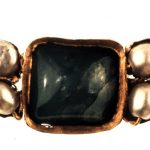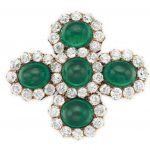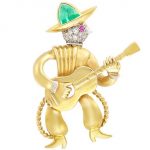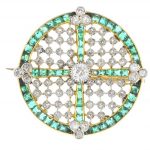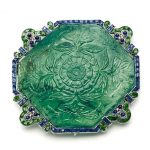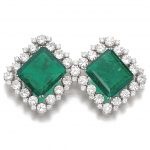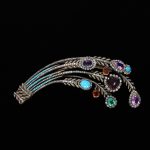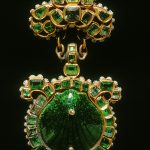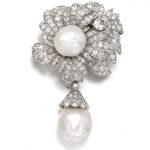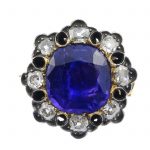Information and history of emeralds plus a gallery of emeralds used in antique and vintage brooches. Emeralds are the birthstone for May, however, their beautiful colour has made them a popular gemstone for any time of the year.
Emeralds, like all colored gemstones, are graded using four basic parameters–the four Cs of connoisseurship: color, clarity, cut and carat weight. Normally, in the grading of colored gemstones, color is by far the most important criterion. However, in the grading of emeralds, clarity is considered a close second. A fine emerald must possess not only a pure verdant green hue but also a high degree of transparency to be considered a top gem.
n the 1960s, the American jewelry industry changed the definition of emerald to include the green vanadium-bearing beryl. As a result, vanadium emeralds purchased as emeralds in the United States are not recognized as such in the UK and Europe. In America, the distinction between traditional emeralds and the new vanadium kind is often reflected in the use of terms such as “Colombian emerald”. Reference: Wikipedia
A ‘panthère’ brooch, by Cartier Realistically modelled as a panther, decorated with black enamel spots and pear-shaped emerald eyes, signed Cartier, maker’s mark, numbered, French assay marks, length 6.6cm
Sold for £6,000 inc. premium at Bonhams in 2018
Roman gold brooch with an emerald flanked by pearls. 2ndC-3rdC
AN EMERALD AND DIAMOND BROOCH Centering upon a circular cabochon emerald, within an old-cut diamond surround, flanked on each side by a similarly set oval cabochon emerald, measuring approximately 11.10 x 9.60 to 10.20 x 9.9 mm, 1 3/4 ins., mounted in gold Accompanied by report no. 1087614 dated 19 October 2017 from the AGL American Gemological Laboratories stating that it is the opinion of the Laboratory that the origin of these emeralds would be classified as Colombia, with insignificant to minor clarity enhancement, traditional type Provenance Formerly from the collection of the Aleksandr Ivanovich Nelidov (1838-1910) and Olga Dmitrievna Princess Nelidov
Sold for USD 106,250 at Christies in 2017
Retro Two-Color Gold, Emerald, Diamond and Ruby Cowboy Brooch 18 kt. yellow & white gold, one triangular-shaped cabochon emerald, 10 single-cut diamonds ap. .20 ct., one round cabochon ruby, c. 1940, ap. 8.3 dwts.
Emerald: medium green color, moderately included, well-cut Diamonds: G-H/SI Ruby: pinkish-red color, moderately included, lively Overall in good condition, normal wear. Measuring ap. 1 3/4 x 1 3/8
Sold for $1,250 (includes buyer’s premium) at Doyle New York in 2018
An Edwardian diamond and emerald brooch. Designed as an old-cut diamond and calibre-cut emerald cross, within an old-cut diamond lattice and calibre-cut emerald circular surround. Estimated total diamond weight 0.50ct. Diameter 2.6cms. Weight 6.9gms.
Sold for £820 at Fellows in 2018
This large octagonal Mughal emerald is decorated with a carved lotus blossom rosette and four leafy stalks extending in the cardinal directions. The stone itself is thin, having been cut down, perhaps in the early twentieth century, when it was set in a platinum mount by Cartier. Although the stone originally may have been set in a bazuband, armor worn by men on the upper arm, Cartier repurposed it as a brooch, presumably for a woman. Along the edges of the octagon, square cabochon sapphires alternate with an emerald-set arch enclosing a trefoil of three round cabochon sapphires and terminating in emerald volutes, intersected on each side by two sapphires. The brooch may have been made for one of Cartier’s American clients.
Reference: The Metropolitan Museum of Art
Emerald and diamond brooch of geometric design, set with two step-cut emeralds weighing respectively 14.61 and 12.42 carats, within frames of circular-cut diamonds.
Accompanied by SSEF report no. 82328, stating that the emeralds are of Colombian origin, with a moderate amount of oil in fissures.
Sold for 106,250 CHF at Sothebys in 2018
Aigrette, brilliant-cut diamonds, turquoises, an emerald and other coloured stones, probably made in France, about 1810
Reference: © Victoria and Albert Museum
Badge of the Order of Santiago de Compostela
The religious Order of St. James (Sant Iago) was a military order established in 1171 at the pilgrimage cathedral of Santiago de Compostela in Spain to protect it from attacks by Muslims. Pilgrims to the church frequently ate scallops and attached the empty shells to their hats. Members of the order adopted the scallop shell as their badge. Made from gold, enamel, emeralds, diamonds
Reference: The Walter Art Museum

